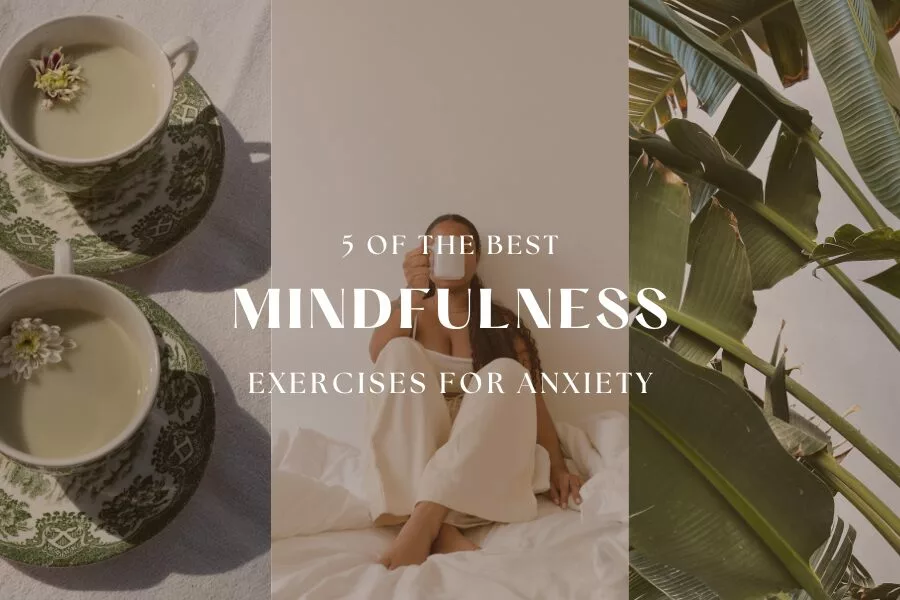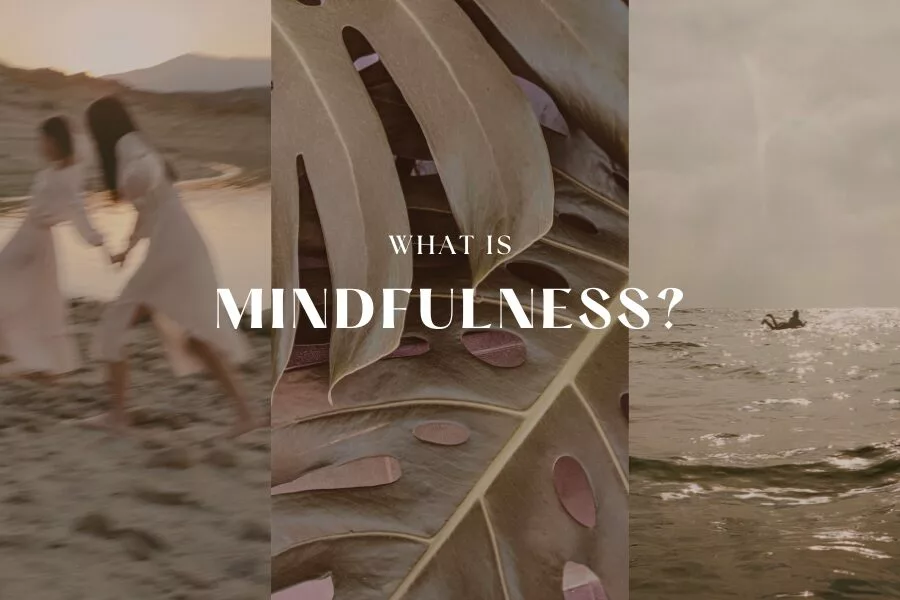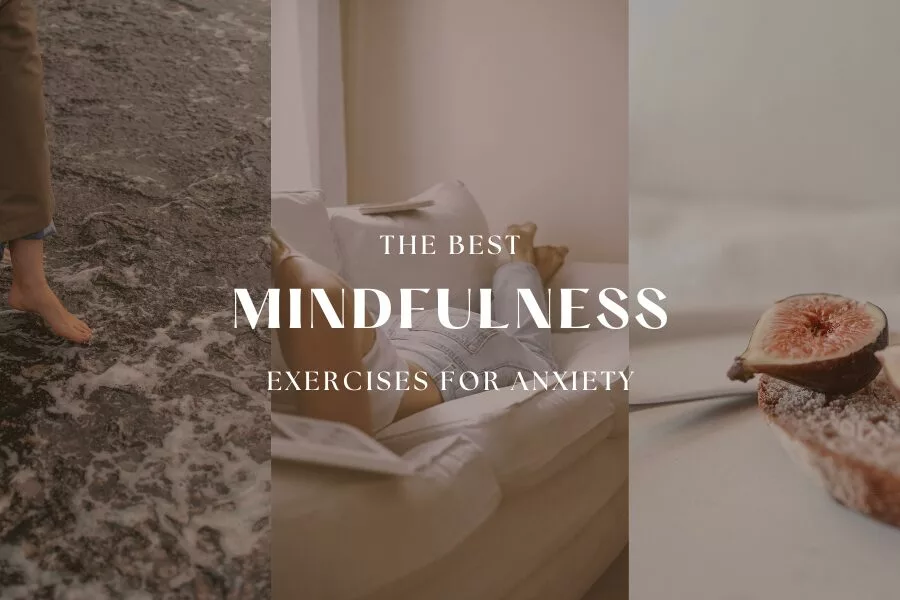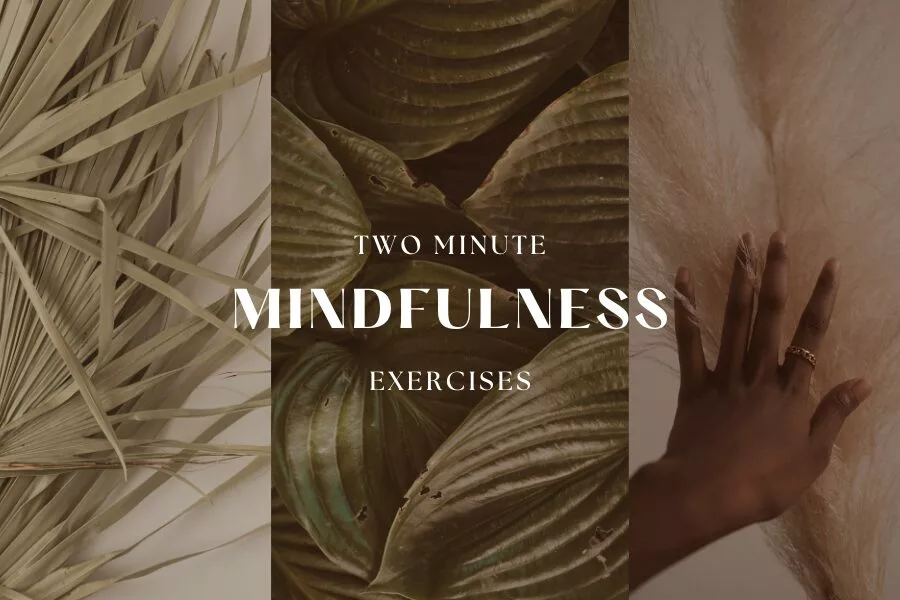5 Best Mindfulness Exercises For Anxiety
Looking to calm your mind? Here are 5 of the best mindfulness exercises for anxiety.

Mindfulness, rooted in ancient Buddhist practices, has gained significant traction in modern psychology for its profound effects on reducing anxiety. Incorporating mindfulness exercises into daily routines can help individuals cultivate a heightened sense of awareness and alleviate the grip of anxiety.
In this article we’ll go over what is mindfulness, 5 best mindfulness exercises for anxiety, and two minute mindfulness exercises for when you’re on the go.
After reading this article, you will be fully equipped with the best mindfulness exercises and begin calming your mind and nervous system with ease.
This article is all about the best mindfulness exercises.
What Is Mindfulness?

Mindfulness is a mental state characterized by a focused and non-judgmental awareness of the present moment. It involves deliberately directing one’s attention to their thoughts, feelings, bodily sensations, and the surrounding environment without being overwhelmed or reactive. This practice is rooted in ancient contemplative traditions, particularly within Buddhism, but it has gained widespread popularity and recognition in modern psychology and wellness.
Key elements of mindfulness include:
- Present Moment Awareness: Mindfulness emphasizes being fully engaged in the current moment, acknowledging and accepting one’s experiences without dwelling on the past or anticipating the future.
- Non-Judgmental Attention: Practitioners of mindfulness strive to observe their thoughts and emotions without attaching judgments or evaluations. This involves accepting thoughts and feelings as they are, without categorizing them as good or bad.
- Focused Attention: Mindfulness often involves directing attention to a specific focal point, such as the breath, bodily sensations, or a particular sound. This helps anchor the mind and prevent it from wandering.
- Acceptance and Openness: Mindfulness encourages an attitude of acceptance toward one’s experiences, whether they are positive or negative. Rather than resisting or suppressing emotions, individuals are encouraged to acknowledge and observe them with openness.
Mindfulness is commonly cultivated through various practices, including meditation techniques, breathing exercises, and mindful movement such as yoga. These practices aim to train the mind to become more aware, centered, and resilient to the challenges of daily life.
Numerous studies have demonstrated the positive effects of mindfulness on mental well-being, stress reduction, and the treatment of conditions like anxiety and depression. As a result, mindfulness has become a widely recommended tool in therapeutic settings and is embraced by individuals seeking to enhance their overall quality of life.
5 of The Best Mindfulness Exercises for Anxiety

When you are in the midst of a panic attack, it might be hard to remember or even perform these exercises. For that reason, I suggest doing one or two of these exercises daily, in order to become familiar with the methods. In the process you will be actively calming the nervous system twice a day. It will also help make these mindfulness routines feel like second nature. So when anxiety hits, you’ll already know what to do.
- Deep Breathing Meditation:
- Description: Sit or lie down in a comfortable position. Close your eyes and bring your attention to your breath. Inhale deeply through your nose, allowing your lungs to fill completely. Hold for a moment, then exhale slowly through your mouth. Focus solely on the sensation of breathing, letting go of any intrusive thoughts.
- Benefits: Deep breathing calms the nervous system, reduces heart rate, and anchors the mind to the present moment, diminishing the power of anxious thoughts.
- Body Scan Technique:
- Description: Lie down in a quiet space. Start at your toes and progressively move your attention up through each part of your body, noticing any sensations or tension. As you identify areas of tightness or discomfort, consciously release the tension and relax those areas.
- Benefits: The body scan promotes awareness of bodily sensations, helping individuals recognize and alleviate physical manifestations of anxiety.
- Mindful Walking:
- Description: Take a walk in nature, preferably in a quiet park or forest. Pay attention to each step, the movement of your feet, and the sensations of walking. Notice the sounds around you, the feeling of the ground beneath, and the rhythm of your breath.
- Benefits: Mindful walking combines physical activity with mindfulness, grounding individuals in the present and fostering a deeper connection with the environment, which can be therapeutic for anxiety.
- Guided Imagery:
- Description: Find a comfortable position and close your eyes. Visualize a peaceful place, such as a serene beach or a tranquil forest. Engage all your senses in this visualization – feel the warmth of the sun, hear the gentle waves, and smell the fresh air. Stay immersed in this calming imagery for a few minutes.
- Benefits: Guided imagery distracts the mind from anxious thoughts, creating a mental sanctuary where one can find relaxation and peace.
- Mindful Journaling:
- Description: Set aside a few minutes each day to write down your thoughts, feelings, and experiences without judgment. Reflect on your emotions, the triggers for anxiety, and any patterns you notice. Approach your journaling with curiosity and kindness towards yourself.
- Benefits: Mindful journaling provides a structured outlet for processing emotions, gaining insights into the root causes of anxiety, and fostering self-compassion.
Two Minute Mindfulness Exercises

Two-minute mindfulness exercises are quick and accessible practices that can help anchor your attention, reduce stress, and cultivate a sense of presence. Here are some simple two-minute mindfulness exercises you can try:
- Deep Breathing:
- Find a comfortable seated position.
- Close your eyes and take a deep breath in through your nose, counting to four.
- Hold the breath for a count of four.
- Exhale slowly through your mouth for a count of four.
- Repeat this cycle several times, focusing on the sensation of the breath.
- Body Scan:
- Sit comfortably and close your eyes.
- Bring your attention to your toes, noticing any sensations, tension, or warmth.
- Gradually move your attention up through each part of your body, from your feet to your head.
- Notice any areas of tension or relaxation without trying to change them.
- Mindful Observation:
- Choose an object within your environment, such as a pen, a plant, or a piece of artwork.
- Take a moment to observe the object closely, noticing its colors, textures, and shapes.
- Allow yourself to become fully absorbed in the experience of observing the object.
- Sensory Awareness:
- Close your eyes and take a deep breath.
- Tune into your senses, one by one. Notice:
- Five things you can see.
- Four things you can touch.
- Three things you can hear.
- Two things you can smell.
- One thing you can taste.
- Loving-Kindness Meditation:
- Close your eyes and take a few deep breaths.
- Think of someone you care about and silently repeat phrases of loving-kindness toward them, such as “May you be happy, may you be healthy, may you be at peace.”
- Allow feelings of warmth and compassion to arise within you.
- Try one of our free meditation soundtracks!
These two-minute mindfulness exercises offer a brief but effective way to pause, reconnect with the present moment, and cultivate a greater sense of calm and awareness. Incorporating these practices into your daily routine can help you navigate stressors with greater ease and promote overall well-being.
In conclusion, the best mindfulness exercises for anxiety offer tools to anchor oneself in the present moment, cultivate self-awareness, and develop a compassionate relationship with one’s thoughts and emotions. By integrating these practices into daily life, individuals can build resilience against anxiety and pave the way for a calmer, more centered existence. Embracing mindfulness is not merely a trend but a transformative journey towards inner peace and well-being.
This article was all about the best mindfulness exercises.





